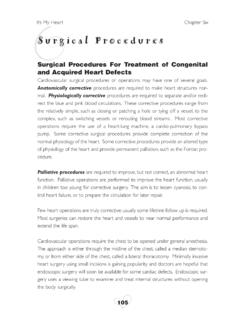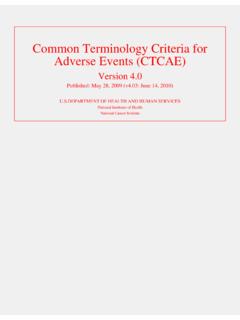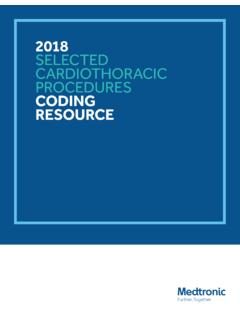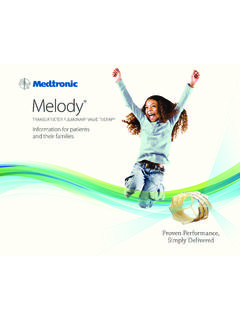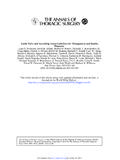Transcription of Chronic Wound Care Guidelines
1 Chronic Wound care Guidelines Abridged Version The Wound Healing Society Table of Contents Venous Ulcer ..4. Pressure Ulcer ..10. Diabetic Ulcer ..16. Arterial Insufficiency Ulcer ..22. References ..28. The Wound Healing Society FOREWORD. The publication of the Wound care Guidelines by the Wound Healing Society in the December 2006 issue of Wound Repair and Regeneration represents the culmination of a three-year effort involving numerous individuals and entities. As the Principal Investigator and Chief Editor of this work, I think that a brief history of the genesis and completion of this project is absolutely necessary. In addition, it allows for the recognition of the effort by so many into the development of this project. In early 2003, the Wound Healing Foundation, under the leadership of Dr. Elof Eriksson, put out a request for proposal (RFP) for a project to formulate and publish Minimal Standards for the Diagnosis and Treatment of Chronic Wounds: General and Specific.
2 The RFP emphasized that the most common Chronic wounds pressure ulcers, venous stasis ulcers and diabetic foot ulcers are increasing in prevalence in the population, owing primarily to an ever-increasing number of elderly patients. Moreover, despite many recent advances in Wound care , the challenge of managing Chronic wounds is compounded by the current lack of uniformly accepted diagnostic methods to evaluate outcomes and consensus on clearly defined, comprehensive Wound care standards. The WHS was extremely gratified when its proposal was accepted. The committees and respective Chairs were selected and charged with the necessary research and writing in June 2005. The successful completion of their task within a short period of six to eight months bespeaks of their hard work, dedication to the goals of the project and unwavering commitment. Several unique features of this project need to be stressed.
3 First, consensus was the order of the day and was maintained throughout: in the broad and comprehensive research of existing literature; in the make-up of work groups to include all specialties, disciplines, professional degrees or societies (various clinical fields such as dermatology, endocrinology, vascular surgery, plastic surgery, podiatric medicine, geriatrics, nursing, dietetics/nutrition, rehabilitative services and prosthetics are all 2. represented); in the application of Delphi process in that the vast majority of the group had to be in agreement with any pronouncement or recommendation; and, finally, in the seeking of input from all interested parties, societies and industry at publicly held forums on the NIH campus in October 2005 and February 2006. The astute reader will notice that the term standard was dropped in favor of the term guideline.
4 It was felt that the latter term more accurately reflected the intent, the frequent lack of strong evidence or the legal implication of the former term. Unique to these documents are: the inclusion of animal data as reflective of biological, if not necessarily clinical, evidence; the lack of any agenda, as no industrial or other interest group or funding was sought; and, finally, the inclusion of clinicians, academicians and bench scientists in the group. The publication of the Guidelines represents only a beginning. The WHS has formed a Guideline Update Committee chaired by Dr. Martin Robson. Its duties include the continued examination of the validity and currency of the documents, as well as their periodic update and republication. I would like to conclude by recognizing several individuals who have helped and encouraged me in this project: Dr. Elof Eriksson, whose unwavering trust, help and friendship have been invaluable and who remains as committed today as he was in 2003.
5 To the value of this project; his efforts in diplomacy and science are a constant source of inspiration; Dr. Lillian Nanney, whose faith and trust in me was an impetus to complete the project; to the Chairs of the four committees: Drs. Martin Robson, David Steed, Harriet Hopf, Joie Whitney and Linda Phillips, all of whom kept their focus, the time frame imposed and required virtually no urgings on my part; all committee members whose work is truly represented here. Adrian Barbul, MD, FACS. President, The Wound Healing Society 3. VENOUS ULCER. 1. Diagnosis Arterial disease should be ruled out: Pedal pulses are present ABI > ABI < suggests vascular disease; if ABI < then compression therapy is contraindicated. In elderly patients, diabetic patients or patients with ABI > , Toe:brachial index > or transcutaneous oxygen pressure of > 30 mm Hg may help to suggest adequate arterial flow.
6 Color duplex ultrasound scanning or Valsalva maneuver is useful in confirming venous etiology. If suspecting sickle cell disease, diagnose with sickle cell prep and hemoglobin electrophoresis. If ulcer is older than three months or not responsive after six weeks of therapy, biopsy for histological diagnosis (possible malignancy or other disease). If worsening despite treatment or excessively painful, consider other diagnoses such as pyoderma gangrenosum, IgA. monoclonal gammopathies, Wegener's granulomatosis, cutaneous Chronic granulomatous disease and mycobacterial or fungal etiologies (high suspicion for ulcers with dark color, blue/purple border, concomitant with systemic disease such as Crohn's disease, ulcerative colitis, rheumatoid arthritis, other collagen vascular diseases, leukemia). Specific cultures for mycobacteria and/or fungi are useful, as biopsies for histology.
7 2. Lower Extremity Compression Use of Class 3, high-compression system is indicated. The degree of compression must be modified when mixed venous/arterial disease is confirmed during the diagnostic work-up. Intermittent pneumatic leg compression (IPC) can be used with or without compression (other option for patients who cannot or will not use adequate compression). Because venous hypertension is an ongoing condition, a degree of compression therapy should be continued constantly and forever. (See Long-Term Maintenance Guidelines on Page 9.). 4. VENOUS ULCER. 3. Infection Control Debridement Remove necrotic, devitalized tissue by sharp, enzymatic, mechanical, biological or autolytic debridement. Infection Assessment If infection is suspected in a debrided ulcer, or if epithelialization from the margin is not progressing within two weeks of debridement and initiation of compression therapy, determine the type and level of infection in the debrided ulcer by tissue biopsy or by a validated quantitative swab technique.
8 Treatment If 106 CFU/g of tissue or any beta hemolytic streptococci, use topical antimicrobial (discontinue once in bacterial balance to minimize cytotoxicity and development of resistance). Systemically administered antibiotics do not effectively decrease bacterial levels in granulating wounds;. however, topically applied antimicrobials can be effective. Cellulitis (inflammation and infection of the skin and subcutaneous tissue most commonly due to streptococci or staphylococci) around ulcer should be treated with systemic gram-positive bactericidal antibiotics. Minimize the tissue level of bacteria, preferably to 105. CFU/g of tissue, with no beta hemolytic streptococci in the venous ulcer prior to attempting surgical closure by skin graft, skin equivalent, pedicled or free flap. 5. VENOUS ULCER. 4. Wound Bed Preparation Examine patient as a whole to evaluate and correct causes of tissue damage: A) Systemic diseases (autoimmune diseases, major surgery, Chronic smoking) and medications (immunosuppressive drugs and systemic steroids).
9 B) Nutrition C) Tissue perfusion and oxygenation Debridement Perform initial debridement and maintenance debridement (sharp, enzymatic, mechanical, biological or autolytic). Choose method of debridement depending on the status of the Wound , the capability of the healthcare provider and the overall condition of the patient. Cleansing Cleanse Wound initially and at each dressing change using a neutral, nonirritating and nontoxic solution. Routine Wound cleansing should be accomplished with a minimum of chemical and/or mechanical trauma. Sterile saline or water is usually recommended. Tap water should only be used if the water source is reliably clean. A nontoxic surfactant may be useful, as may fluid delivered by increased intermittent pressure. Documentation of Wound History Document Wound history, recurrence and characteristics (location, staging, size, base, exudates, infection condition of surrounding skin and pain).
10 The rate of Wound healing should be evaluated to determine if treatment is optimal. 6. VENOUS ULCER. 5. Dressings Use dressing that maintains a moist Wound healing environment. Use clinical judgment to select moist Wound dressing that facilitates continued moisture. Wet-to-dry dressings are not considered continuously moist and are an inappropriate Wound dressing selection. Select dressing to manage exudates and protect peri- Wound skin. Select a dressing that stays in place, minimizes shear and friction, and does not cause additional tissue damage. VENOUS ULCER PATIENTS ARE PARTICULARLY. SUSCEPTIBLE TO CONTACT DERMATITIS RELATED. TO TOPICAL THERAPIES. Select dressing that is cost-effective and appropriate to the ulcer etiology, the setting and the provider. Consider healthcare provider time, ease of use and healing rate, as well as the unit cost of the dressing.

